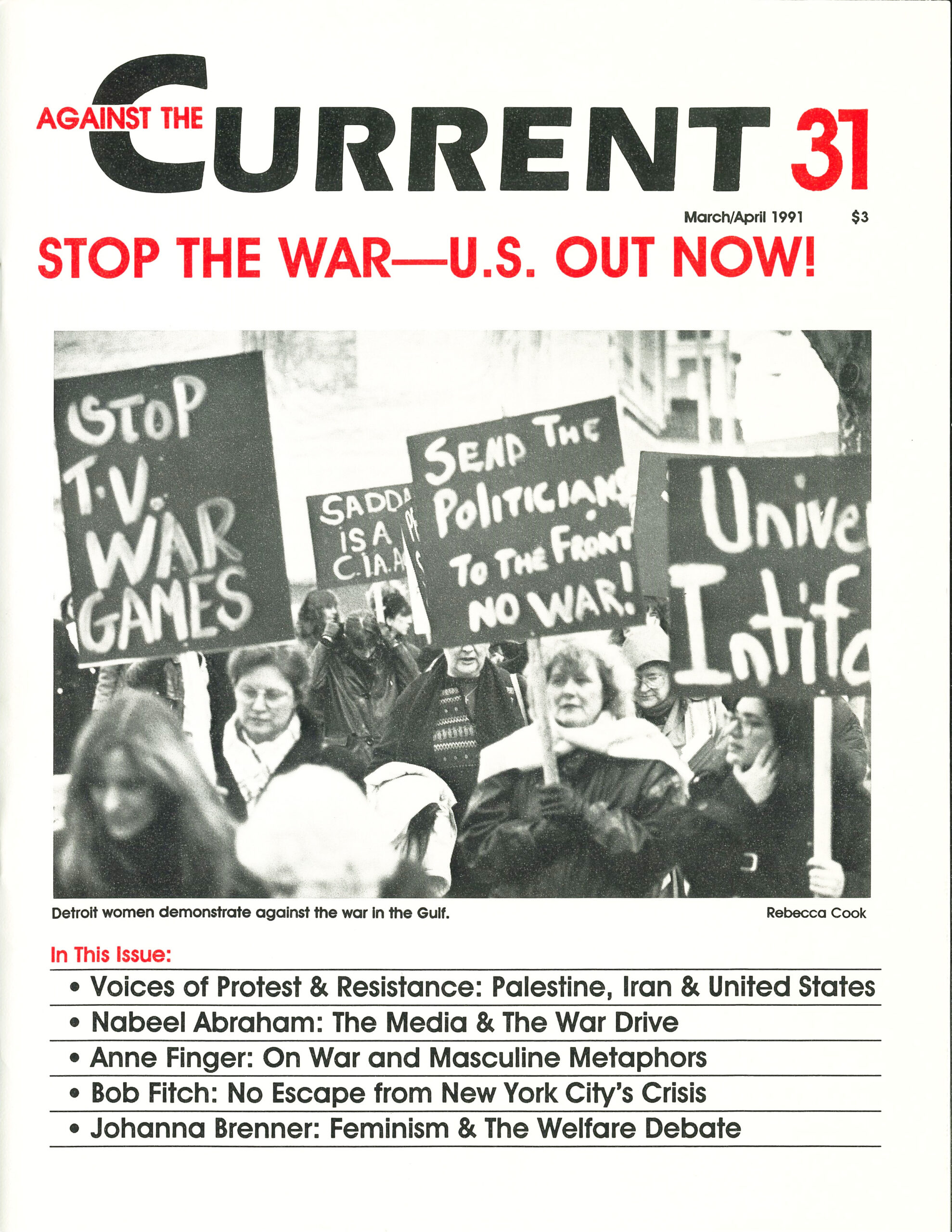Against the Current, No. 31, March/April 1991
-
Bring the Troops Home Now!
— The Editors -
What a Friend We Have in Dinkins
— Bob Fitch - International Women's Day--1991
-
The Rebel Girl: The Rapping Rebel
— Catherine Sameh -
Toward a Socialist-Feminist Strategy
— Johanna Brenner -
Women's Blood at the Root
— Mechthild Nagel -
Toward a New Imperium?
— interview with Janice Terry -
Palestine's Difficult Prospects
— interview with Anan Ameri -
Gulf War: An Iranian Perspective
— interview with Ali M. -
A Community Under Siege
— interview with Jessica Daher - The Intifada and Women's Struggle
-
Chemical War Against Civilians
— Israel Shahak -
Missiles, Masculinity and Metaphors
— Anne Finger -
The Media and the War Drive
— Nabeel Abraham -
Eco-Apocalypse Now
— Richard Latker -
A Hard Rain's Goin' to Fall
— John M. Miller -
Emergence of Iranian Workers
— Ali M. -
Citizenship and Civil Rights in Kuwait
— interview with Mahmood Ibrahim -
Tikkun and the Gulf War
— Justin Schwartz -
The Soviet Union and Iraq
— Hillel Ticktin -
Iraq: The Republic of Fear
— Joseph A. Massad -
Soviet Union-Eastern Europe, Part II: Nature of the Transition
— Robert Brenner -
Sexist and Misguided
— Sabiyha Robin Graham -
Another Commy Plot?
— John Vandermeer -
Random Shots: The Gulf War Miseries
— R.F. Kampfer
Israel Shahak
This item appeared in the Israeli newsletter News From Within, published by the Alternative Information Center in Jerusalem, January 5, 1991.
ON SATURDAY, DECEMBER 29, 1990 four young Palestinians were killed at the refugee camp beside Rafah in the Gaza Strip by members of an “elite” unit of the Israeli Defense Force. Two were masked youth who had been painting slogans on walls. They were commanded to stop, and shot attempting to flee.
This was an example of putting into practice “new open-fire procedures.” The other two were killed by gunfire from the same unit, when large numbers of camp residents gathered and entered into confrontations with the army upon hearing of the first killings. Some 150 persons were injured by live ammunition according to Palestinian sources—ninety seven according to the IDF spokesman.
Huge quantities of gas were unleashed on the camp residents, including from helicopters. A member of the Israeli Knesset (parliament), Tamar Gujanski (from the Maki party), was given samples of the gas grenades by residents of the camp, and she passed them on to chemist Israel Shahak of the Hebrew University for analysis.
Below is professor Shahak’s report
Statement on CS Gas
THE “TEAR GAS” which is actually a solid (all tear “gasses” and poison “gasses” are solids or more often liquids), designated as CS and whose full name is 2-Chlorobenzylidene Malonitrile, is thought of as the most dangerous of all the “gasses” in non-war use, for the following reasons.
1) It is a stable material. Its action is likely to continue for a long time, as opposed to “CN gas,” which breaks down in water or moist air and which was used in the Occupied Territories until a few years ago and is still used within Israel.
2) Since it is a solid, it is used as a concentrate in the form of fine dust. This dust sticks to clothing, clay walls (such as those found in refugee camps), and especially to various sorts of food such as cereals and salad greens. It is carried long distances by the wind and is also liable to accumulate in holes and other places on the ground or walls, where it is protected and doesn’t break down for a long time.
Contact with “old” CS like this, for example in the course of children’s play or home repairs, is liable to be dangerous for years!
3) It causes a very sharp burning sensation of the airways and digestive tract (into which it is likely to enter with food), in the eyes, mouth and sensitive areas of the skin. Its action is especially hard on babies and on children in general, as all of their skin is sensitive; and also on the elderly and sick, who only with difficulty are able to develop resistance to its action.
Its influence continues for a significant period of time, and its continuing action is especially dangerous when it is stuck to walk, clothing, etc. Besides its immediate action, there are a significant number of medical complications related I to cumulative and indirect effects of CS.
4) Despite CS’ stability in ordinary water, it breaks down upon contact with basic substances, such as urine undergoing fermentation, which can be found in refugee camps and other places. When CS accumulates in the ground or comes in contact with urine (or excrement) in the process of bacterial fermentation, its breakdown is liable to yield cyanide, one of the most terrible poisons known.
5) The only way available to residents of the territories to get rid of CS is mechanically: by laundering of clothing, scrubbing of walls, basic cleaning of roads, etc. All this must be done with the hands protected by rubber gloves, and the body covered as well as possible—and especially the mouth and nose should be covered with a damp cloth. When one sprays an inhabited area from above with CS and them imposes a curfew, one prevents these (cleaning) activities and most seriously threatens the health of all the inhabitants, especially as mentioned above–the health of children, the sick and the old.
I would not hesitate to state that the spraying of CS from the air—which is an action entirely impossible to control—and the imposition of a curfew after its wide use, should be thought of as war crimes.
March-April 1991, ATC 31

